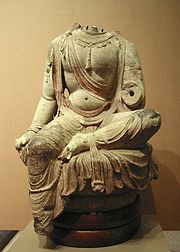
Four Olds
Encyclopedia

Cultural Revolution
The Great Proletarian Cultural Revolution, commonly known as the Cultural Revolution , was a socio-political movement that took place in the People's Republic of China from 1966 through 1976...
in the People's Republic of China
People's Republic of China
China , officially the People's Republic of China , is the most populous country in the world, with over 1.3 billion citizens. Located in East Asia, the country covers approximately 9.6 million square kilometres...
was to bring an end to the Four Olds. The campaign to destroy the Four Olds began in Beijing
Beijing
Beijing , also known as Peking , is the capital of the People's Republic of China and one of the most populous cities in the world, with a population of 19,612,368 as of 2010. The city is the country's political, cultural, and educational center, and home to the headquarters for most of China's...
on August 20, 1966, shortly after the launch of the Cultural Revolution.
Destruction of Chinese cultures and traditional values
Mao ZedongMao Zedong
Mao Zedong, also transliterated as Mao Tse-tung , and commonly referred to as Chairman Mao , was a Chinese Communist revolutionary, guerrilla warfare strategist, Marxist political philosopher, and leader of the Chinese Revolution...
called for the Four Olds to be swept away at the very early stages of the Cultural Revolution
Cultural Revolution
The Great Proletarian Cultural Revolution, commonly known as the Cultural Revolution , was a socio-political movement that took place in the People's Republic of China from 1966 through 1976...
in 1966, and Red Guards
Red Guards (China)
Red Guards were a mass movement of civilians, mostly students and other young people in the People's Republic of China , who were mobilized by Mao Zedong in 1966 and 1967, during the Cultural Revolution.-Origins:...
took up the task with alacrity. As a result, examples of Chinese architecture
Chinese architecture
Chinese architecture refers to a style of architecture that has taken shape in East Asia over many centuries. The structural principles of Chinese architecture have remained largely unchanged, the main changes being only the decorative details...
were destroyed, classical literature
Chinese literature
Chinese literature extends thousands of years, from the earliest recorded dynastic court archives to the mature fictional novels that arose during the Ming Dynasty to entertain the masses of literate Chinese...
and Chinese painting
Chinese painting
Chinese painting is one of the oldest continuous artistic traditions in the world. The earliest paintings were not representational but ornamental; they consisted of patterns or designs rather than pictures. Early pottery was painted with spirals, zigzags, dots, or animals...
s were torn apart, and cultural and religious customs were vilified as manifestations of feudalism. Many families' long kept genealogy book
Genealogy book
A genealogy book or register is used in Asia, and Europe to record the family history of ancestors.-Chinese genealogical books:It is the Chinese tradition to record family members in a book, including every male born in the family, who they are married to, etc...
s were burned to ashes. During that time, many ancient Chinese cultural artifacts were destroyed forever. People in possession of these goods were punished. Intellectual
Intellectual
An intellectual is a person who uses intelligence and critical or analytical reasoning in either a professional or a personal capacity.- Terminology and endeavours :"Intellectual" can denote four types of persons:...
s were targeted as personifications of the Four Olds, and sometimes they were mocked, harassed, imprisoned, torture
Torture
Torture is the act of inflicting severe pain as a means of punishment, revenge, forcing information or a confession, or simply as an act of cruelty. Throughout history, torture has often been used as a method of political re-education, interrogation, punishment, and coercion...
d, or killed.
Upon learning that Red Guards were approaching the Forbidden City
Forbidden City
The Forbidden City was the Chinese imperial palace from the Ming Dynasty to the end of the Qing Dynasty. It is located in the middle of Beijing, China, and now houses the Palace Museum...
, Premier Zhou Enlai
Zhou Enlai
Zhou Enlai was the first Premier of the People's Republic of China, serving from October 1949 until his death in January 1976...
ordered the gates shut and troops posted, knowing of the Red Guard's reputation for destroying cultural objects.
Popular slogans
- “breaking down the four olds, setting up the four news (old versions of other four concepts)”
- “beating down the bad elements”
- “beating down imperialism”
- “beating down foreign religion”
- “beating down Jesus following”
- “beating down the counter revolutionists”
Communist Party response
No official statistics have ever been produced by the Communist party in terms of reporting the actual cost of damage. By 1978, many stories of death and destruction caused by the Cultural Revolution had leaked out of China and became known worldwide.Restoration
Starting in the 1990s and continuing into the 21st century, there has been a massive rebuilding effort underway to restore and rebuild cultural sites that were destroyed or damaged during the Cultural RevolutionCultural Revolution
The Great Proletarian Cultural Revolution, commonly known as the Cultural Revolution , was a socio-political movement that took place in the People's Republic of China from 1966 through 1976...
. This has coincided with a resurgence in interest in, and demand for, Chinese cultural artifacts. Some have exploited this increased demand, producing counterfeit artifacts.
See also
- Burning of books and burying of scholarsBurning of books and burying of scholarsBurning of the books and burying of the scholars is a phrase that refers to a policy and a sequence of events in the Qin Dynasty of Ancient China, between the period of 213 and 206 BC. During these events, the Hundred Schools of Thought were pruned; legalism survived...
- DesinicizationDesinicizationDesinicization is a term that describes the act of the elimination of Chinese influence, which is the opposite of "sinicization".-Historical:...
- List of campaigns of the Communist Party of China

